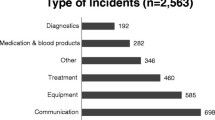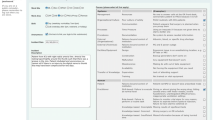Abstract
Purpose
The aim of this study was to evaluate the frequency of surgical and organizational events that occurred in the whole Department of Paediatric Surgery at Gaslini Children’s Hospital through an incident-reporting system in order to identify the vulnerabilities of this system and improve it.
Materials and methods
This is a 6-month prospective observational study (1st January–1st July 2010) of all events (including surgical and organizational events, and near misses) that occurred in our department of surgery (pediatric surgery, orthopedics and neurosurgery units).
Results
Over a 6-month study period, 3,635 children were admitted: 1,904 out of 3,635 (52.4%) children underwent a surgical procedure. A total number of 111 adverse events and 4 near misses were recorded in 100 patients. A total of 108 (97.3%) adverse events occurred following a surgical procedure. Of 111 adverse events, 34 (30.6%) required re-intervention. Eighteen of 100 patients (18%) required a re-admission, and 18 of 111 adverse events (16.2%) were classified as organizational. Infection represented the most common event.
Conclusions
An electronic physician-reported event tracking system should be incorporated into all surgery departments to report more accurately adverse events and near misses. In this system, all definitions must be standardized and near misses should be considered as important as the other events, being a rich source of learning.
Similar content being viewed by others
References
Short TG, O’Regan A, Jayasuriya JP et al (1996) Improvements in anaesthetic care resulting from a critical incident reporting programme. Anaesthesia 51(7):615–621
Marcus R (2006) Human factors in pediatric anesthesia incidents. Paediatr Anaesth 16(3):242–250
Mattioli G, Avanzini S, Pini-Prato A et al (2009) Risk management in pediatric surgery. Pediatr Surg Int 25(8):683–690 Epub 2009 Jun 27
Leape LL, Brennan TA, Laird N et al (1991) The nature of adverse events in hospitalized patients. Results of the Harvard Medical Practice Study II. N Engl J Med 324(6):377–384
Morimoto T, Sakuma M, Matsui K et al. (2010) Incidence of adverse drug events and medication errors in Japan: the JADE Study. J Gen Intern Med Sep 25. [Epub ahead of print]
Wright AA, Katz IT (2005) Bar coding for patient safety. N Engl J Med 353(4):329–331
Tay CL, Tan GM, Ng SB (2001) Critical incidents in paediatric anaesthesia: an audit of 10,000 anaesthetics in Singapore. Paediatr Anaesth 11(6):711–718
Mahajan RP (2010) Critical incident reporting and learning. Br J Anaesth 105(1):69–75
Ahn JH, Phi JH, Kang HS et al (2010) A ruptured middle cerebral artery aneurysm in a 13-month-old boy with Kawasaki disease. J Neurosurg Pediatr 6(2):150–153
Kim JH, Kang JA, Kim JS et al (2010) Isolated cerebrospinal fluid leakage due to a spinal stab wound in a child. Pediatr Neurosurg 46(1):43–45 Epub 2010 May 27
Sanderson JD, Kountakis SE, McMains KC (2009) Endoscopic management of cerebrospinal fluid leaks. Facial Plast Surg 25(1):29–37 Epub 2009 Feb 10
Erdem I, Hakan T, Ceran N (2008) Clinical features, laboratory data, management and the risk factors that affect the mortality in patients with postoperative meningitis. Neurol India 56(4):433–437
Sainte-Rose C, Cinalli G, Roux FE et al (2001) Management of hydrocephalus in pediatric patients with posterior fossa tumors: the role of endoscopic third ventriculostomy. J Neurosurg 95(5):791–797
Chung CY, Chen CL, Cheng PT et al (2006) Critical score of Glasgow Coma Scale for pediatric traumatic brain injury. Pediatr Neurol 34(5):379–387
Hicks JM, Singla A, Shen FH et al (2010) Complications of pedicle screw fixation in scoliosis surgery: a systematic review. Complications of pedicle screw fixation in scoliosis surgery: a systematic review. Spine (Phila Pa 1976) 35(11):E465–E470
Greenberg CC (2009) Learning from adverse events and near misses. J Gastrointest Surg 13(1):3–5 Epub 2008 Sep 17
Hobgood C, Xie J, Weiner B, Hooker J (2004) Error identification, disclosure, and reporting: practice patterns of three emergency medicine provider types. Acad Emerg Med 11:196–199
Bilimoria KY, Kmiecik TE, DaRosa DA et al (2009) Development of an online morbidity, mortality, and near-miss reporting system to identify patterns of adverse events in surgical patients. Arch Surg 144(4):305–311 (discussion 311)
Leape LL (2002) Reporting of adverse events. N Engl JMed 347(20):1633–1638
Weissman JS, Annas CL, Epstein AM et al (2005) Error reporting and disclosure systems: views from hospital leaders. JAMA 293(11):1359–1366
Wanzel KR, Jamieson CG, Bohnen JM (2000) Complications on a general surgery service: incidence and reporting. Can J Surg 43(2):113–117
Barach P, Small SD (2000) Reporting and preventing medical mishaps: lessons from non-medical near miss reporting systems. BMJ 320(7237):759–763
Moiyadi AV, Devi BI, Nair KP (2007) Brachial plexus injuries: outcome following neurotization with intercostal nerve. J Neurosurg 107(2):308–313
Rice-Townsend S, Hall M, Jenkins KJ, Roberson DW, Rangel SJ (2010) Analysis of adverse events in pediatric surgery using criteria validated from the adult population: justifying the need for pediatric-focused outcome measures. J Pediatr Surg 45(6):1126–1136
National Patient Safety Agency. Cleanyourhands campaign (2010) www.npsa.nhs.uk/cleanyourhands
Donskey CJ, Eckstein BC (2009) Images in clinical medicine. The hands give it away. N Engl J Med 360(3):e3
Frey B, Schwappach D (2010) Critical incident monitoring in paediatric and adult critical care: from reporting to improved patient outcomes? Curr Opin Crit Care. Oct 7. [Epub ahead of print]
Vincent C, Taylor-Adams S, Stanhope N (1998) Framework for analysing risk and safety in clinical medicine. BMJ 316(7138):1154–1157
Reason JT (1990) Human error. Cambridge University Press, New York
Reason JT (1995) Understanding adverse events: human factors. In: Vincent CA (ed) Clinical risk management. BMJ Publications, London, pp 31–54
van Beuzekom M, Boer F, Akerboom S et al (2010) Patient safety: latent risk factors. Br J Anaesth 105(1):52–59
Acknowledgments
The authors would like to thank Mrs. Francesca Roncallo for her valuable organizational and data retrieval support.
Author information
Authors and Affiliations
Corresponding author
Rights and permissions
About this article
Cite this article
Mattioli, G., Guida, E., Montobbio, G. et al. Near-miss events are really missed! Reflections on incident reporting in a department of pediatric surgery. Pediatr Surg Int 28, 405–410 (2012). https://doi.org/10.1007/s00383-011-3047-5
Accepted:
Published:
Issue Date:
DOI: https://doi.org/10.1007/s00383-011-3047-5




